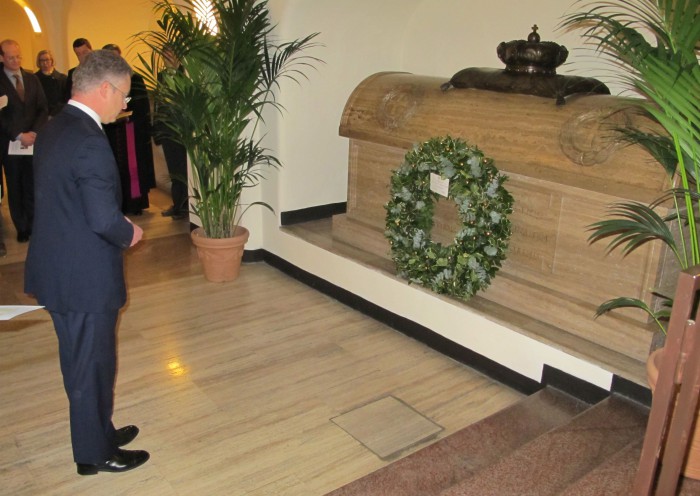8th January 2016
History and healing: remembering the Stuarts


On 8 January, with the gracious permission of Her Majesty The Queen, I laid a wreath at the tomb in the crypt of St Peter’s Basilica of James Francis Edward Stuart, 250 years after his burial there. The message on the wreath was very simple: “In memoriam – James Francis Edward Stuart – ‘The Chevalier’ – 1688-1766”.
Why, you may ask? What has that to do with the British Embassy to the Holy See?
James Francis Edward Stuart had other names. ‘The Chevalier’ to his friends and admirers, he was “The Old Pretender” to his enemies (to distinguish him from his eldest son, ‘Bonnie’ Prince Charlie, ‘The Young Pretender’), and to his supporters – and, when it suited him, King Louis XIV of France – King James III of England and Ireland, VIII of Scotland. He was the son of James II, deposed in the ‘Glorious Revolution’ of 1688 after a crisis precipitated by his son’s birth, and lived and died in exile. After his death in Rome on New Year’s Day 1766, Pope Clement XIII accorded him the honour of a magnificent State Funeral the following 8 January. In his lifetime, successive Popes always recognised him as King. However, significantly, Clement XIII did not extend that recognition to his sons, in tacit and later explicit recognition of the Hanoverian succession.
So our simple wreath-laying ceremony was, in a way, one of historical reconciliation. The Chevalier always considered himself a patriot, and his court in exile welcomed Britons of all political and religious stripes. His younger son, Henry Benedict, Cardinal York, received a pension from the British Crown after his lands had been seized by Napoleon, and the Prince Regent offered to contribute to the magnificent Stuart monument by Canova that can still be seen in St Peter’s. The tomb in the crypt where I laid the wreath was restored by Queen Elizabeth the Queen Mother, through the good offices of my predecessor, Sir D’Arcy Osborne, in the early 1940’s. And in 2012 HRH The Duke of Gloucester unveiled a restored Coat of Arms of Cardinal York in the Pontifical Scots College, where the original Stuart gravestones had been transferred.
Memory runs deep in Rome. Cardinal Comastri, Archpriest of St Peter’s Basilica (and, as such, a successor of Cardinal York) participated in the wreath-laying ceremony. The Holy See Secretary for Relations with States, Archbishop Gallagher, also attended alongside a number of other senior Holy See officials. The Rectors of the Irish, Scots and Venerable English Colleges – whose predecessors were fired by Clement XIII in 1766 for their untimely enthusiasm for the Stuart cause – attended alongside the Rector of the Pontifical Beda College, representing the British and Irish seminaries in Rome. As did Anglican, Methodist and Church of Scotland guests.
The Chevalier was known for his deep faith, but I hope would have been pleased to have seen participants across the ecumenical divide at this occasion. The presence of the Irish ambassador to the Holy See also reminded us of the importance of commemorating together, rather than remembering apart. The past leaves many wounds. But do not underestimate the healing power of history and remembrance, done well.
I have taken a couple of days in order to cool down. As president of the association – Alliance France-Ecosse- who succeeded in restoring our James VII’s honour in St Germain en Laye back in 1997, now I might as well have a bash at restoring James VIII’s. As a Scot and as a Jacobite, the notion of Auld/Old or Young Pretender just don’t exist. Neither of them were ‘pretending’ at anything – they just WERE. When working on the project in St Germain en Laye and so as not to get things wrong re the text on our memorial plaque, I sought out guidance frae Dr Christopher Smouts – Historiographer Royal in Scotland and also The Court of the Lord Lyon in Edinburgh (and from the French ‘Monuments Historiques’ and the Architects des Batiments de France). Our home grown Scottish authorities on the matter confirmed that as from James VI, King of Scots and 1st of England, it is the Scottish title (being the auldest), that takes precedence over the English one. It thus should be James VIII, King of Scots and III of England. Now I have ‘cooled off’ it just leaves me to say all the best to one and all and Alba Gù Brath
I am pleased to see this take place. I am descended from the brother of Ignatius White, Minister of State to James II, who went into exile with that monarch and died in France in 1694. Honoring the history of the Jacobite cause, without attempting to reverse history, can do much to heal deep divisions. By now, even those of us with ancestors who ardently supported James II also are often descended from those who opposed him. We are also seeking healing within ourselves, as we always should do.
It was good to represent a group of Christians (the Methodists) who were close to Catholics in the 18th century. John Wesley`s mother Susanna was a Stuart supporter. Methodists in the 1740s were suspected of being Jacobites. John Wesley held out an olive branch to Catholics in his letters and sermons. History and its recollection is a great healer of memories especially when it brings those previously divided together. We are grateful to HE Nigel Baker and his colleagues for arranging this simple yet meaningful ceremony in the crypt of St. Peter`s Basilica
Tim Macquiban, Director of the Methodist Ecumenical Office Rome